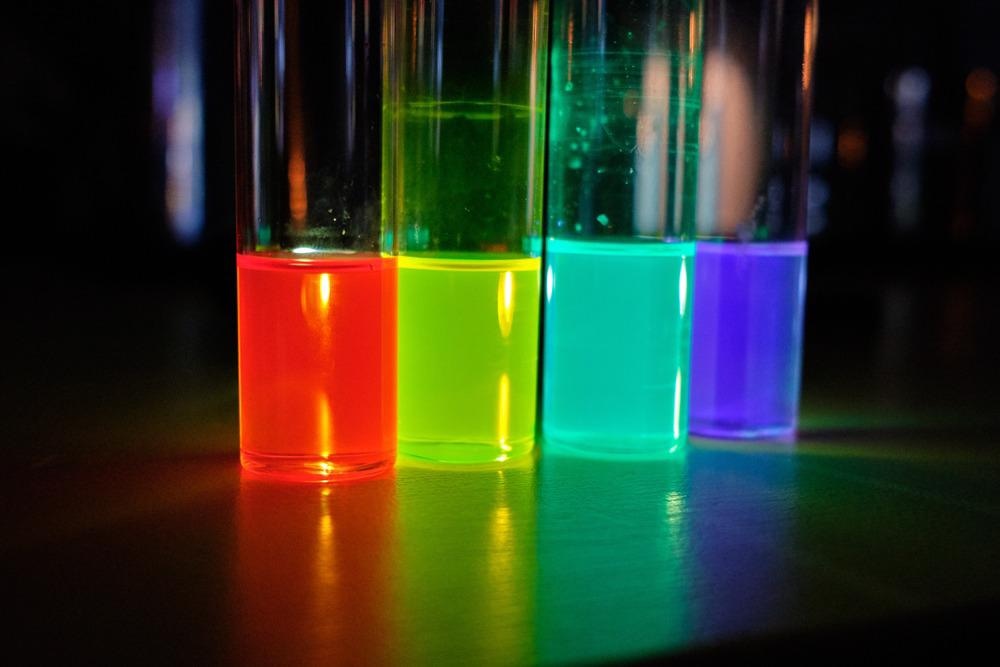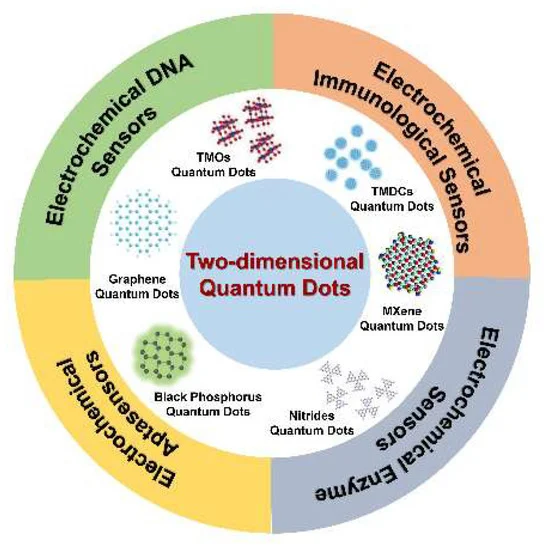 By Surbhi JainReviewed by Susha Cheriyedath, M.Sc.Apr 21 2022
By Surbhi JainReviewed by Susha Cheriyedath, M.Sc.Apr 21 2022In a review recently published in the open-access journal Biosensors, researchers discussed the development of electrochemical biosensors based on quantum dots in two dimensions (2D).

Study: Two-Dimensional Quantum Dot-Based Electrochemical Biosensors. Image Credit: Van Pympk/Shutterstock.com
Background
Since its discovery in 2004, graphene has had a significant impact on a variety of industries, and its success has prompted interest among scientists to investigate additional 2D layered inorganic nanomaterials. To suit the increasing application needs, more 2D materials have been found over time. Due to the strong quantum confinement effect, 2D quantum dots (2D-QDs) can be formed when the lateral dimension of these 2D materials is lowered to <10 nm.
The 2D-QDs' diverse capabilities and properties allow them to be used in a wide range of applications from energy storage, catalysis, and optoelectronics to bioimaging, sensing, and cancer therapy. Biosensors play an important role in our daily lives, from disease diagnosis to detecting biological substances in the environment.
Electrochemical biosensors have exhibited a high signal-to-noise ratio, great sensitivity, fast response times, and relative simplicity in the detection of target analytes among other biosensors. The advent of 2D-nanomaterials, in particular, opens up new possibilities for improving biosensor performance. Despite the fact that 2D-QD-derived electrochemical sensors have garnered a lot of attention and research over the last decade, there are sparse reviews concentrating on 2D-QDs in electrochemical biosensors.
About the Study
In this study, the authors discussed the properties, categories, and synthesis pathways of these 2D-QDs, with an emphasis on their use in electrochemical biosensors.
The researchers introduced the synthesis and category of 2D-QDs, as well as a summary of recent advances in the 2D-QD-based electrochemical sensors to detect biomolecules in the last five years, which was illustrated to provide new ideas and insights for the construction and design of electrochemical devices. Furthermore, the problems and future prospects associated with the preparation of 2D-QD-based electrochemical biosensors were discussed.
The team discussed the properties of existing 2D-QDs based on various 2D materials, such as black phosphorus, graphene, nitrides, transition metal dichalcogenides (TMDCs), transition metal oxides (TMOs), and MXenes, are discussed.

Schematic diagram of 2D-QD-based electrochemical biosensors. Image Credit: Zhang, J et al., Biosensors
Observations
One of the studies reported an electrochemical (ECL) biosensor with a limit of detection (LOD) of 0.33 pM to detect kanamycin (KAN) in the range from 1 pM to 50 nM. S-BN QDsT had a slightly higher average diameter of 9.8 nm than S-BN QDsL with a 9.2 nm diameter, and the corresponding lattice fringes were 0.76 nm and 0.72 nm, respectively.
When compared to BN QDs, the ECL intensities of S-BN QDsT and S-BN QDsL were raised by 1.67 and 2.59 times, respectively. The graphene quantum dots (GQD)-based electrochemical biosensor achieved an excellent linear range of 1 fM to 100 pM and a low LOD of 0.14 fM in the measurement of microRNA-155 due to the catalysis of GQDs and enzyme. For microRNA-25, the suggested GQD-based electrochemical biosensor had a linear range of 0.3 nM to 1.0 µM and a LOD of 95.0 pM.
Significant progress has been achieved in the 2D-QD research, and further research should be done into the catalytic, optical, electrochemical, and electrical properties of 2D QDs. Furthermore, GQDs dominated contemporary 2D-QD research. 2D-QDs were found to be potential candidates for the creation of wearable electrochemical sensors and devices due to their unique qualities of ultra-small diameters and enormous specific surface areas.
Conclusions
In conclusion, this study elucidated that 2D-QD research is being driven by the creation of 2D nanomaterials. Top-down approaches such as hydro/solvothermal methods, ultrasonication-assisted methods, microwave-assisted methods, ion intercalation-assisted methods, and bottom-up approaches such as external microwave methods, hydro/solvothermal methods, and laser-assisted methods have both been successful in producing 2DQDs. Large specific surface areas, strong electrical conductivity, ease of modification, and good biocompatibility have all been established in 2D-QDs, which make them potential candidates in biological sectors.
The authors observed that 2D-QDs have been widely used in the creation of electrochemical biosensors as carriers of sensitive elements, electrode modifiers, luminophores, and electron transfer accelerators due to their superior electrical and optical capabilities, as well as their strong affinity for biomolecules. They mentioned that controllable 2D-QD synthesis remains a challenge, and novel synthetic methods are needed. Also, much less research has been done on 2D-QDs than on their bulk version. They believe that this review would not only pique the interest of researchers toward 2DQDs, but also encourage their continued development and implementation in a variety of sectors.
The team suggested that implantable electrochemical biosensors will also be a research focus in the future, and 2D-QDs will play a significant role in future advances and improvements in biology, physiology, chemistry, and nanotechnology.
Disclaimer: The views expressed here are those of the author expressed in their private capacity and do not necessarily represent the views of AZoM.com Limited T/A AZoNetwork the owner and operator of this website. This disclaimer forms part of the Terms and conditions of use of this website.
Source:
Zhang, J., Zhang, X., Bi, S., Two-Dimensional Quantum Dot-Based Electrochemical Biosensors. Biosensors 12(4) 254 (2022). https://www.mdpi.com/2079-6374/12/4/254